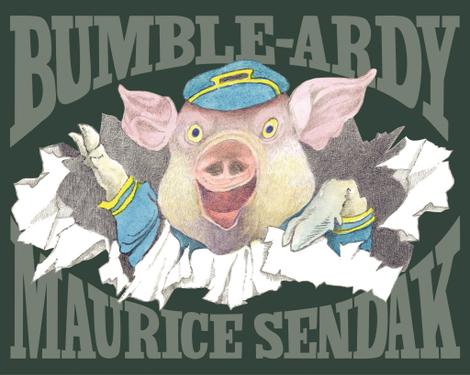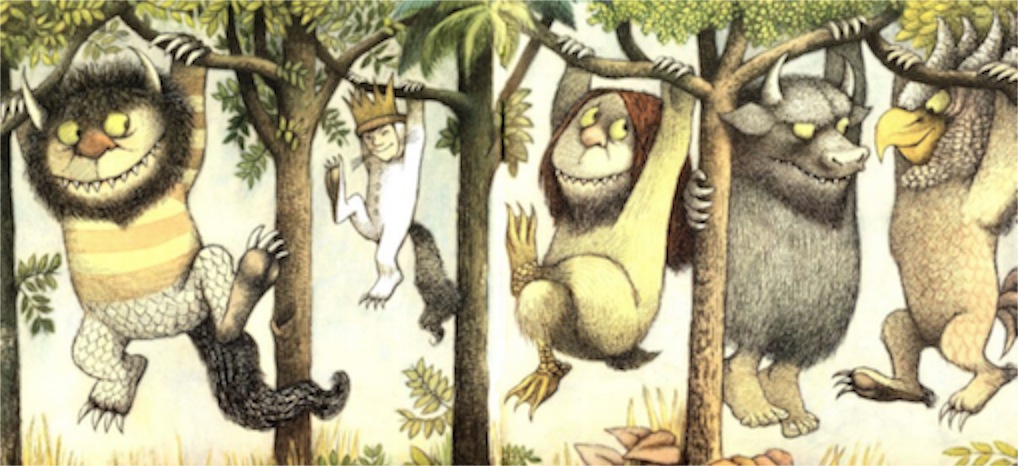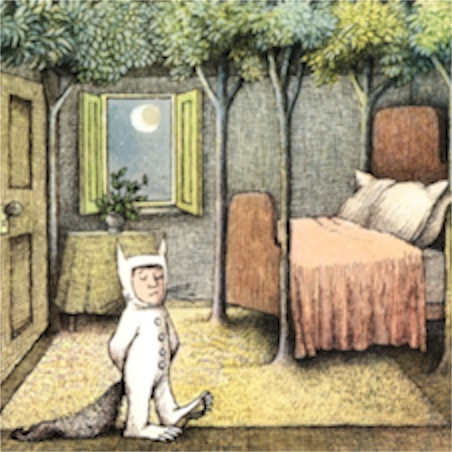Beyond Where the Wild Things Are
09/05/12 05:37
From time to time I write about famous people on the occasion of their death. I know that this is a somewhat strange investment of time and energy because there are already plenty of obituaries that will garner a much wider readership than mine. But when public figure dies, in a way, it is a grief that is spread out more than is the case in the deaths of others. This is not to downplay the real grief experienced by family and friends, but rather to say that there are more of us who experience the loss.
 I am genuinely sad a the news that Maurice Sendak has died. I know that he was 83 years old. I know that he had a stroke. I know that he was not likely to produce any more wonderful books for children. Bumble-Ardy, published in September will be his last book. It was a bonus, coming 30 years after the previous book for which he produced both text and illustrations. It is the story of an orphaned pig who gives himself a wonderful birthday party. Like Sendak’s other books, it combines joy with a dose of reality and even explores fear. The story’s main character became an orphan because his parents were eaten. There are very few children’s story authors with the courage to tackle tough subjects such as where the bacon really comes from.
I am genuinely sad a the news that Maurice Sendak has died. I know that he was 83 years old. I know that he had a stroke. I know that he was not likely to produce any more wonderful books for children. Bumble-Ardy, published in September will be his last book. It was a bonus, coming 30 years after the previous book for which he produced both text and illustrations. It is the story of an orphaned pig who gives himself a wonderful birthday party. Like Sendak’s other books, it combines joy with a dose of reality and even explores fear. The story’s main character became an orphan because his parents were eaten. There are very few children’s story authors with the courage to tackle tough subjects such as where the bacon really comes from.

Like other greats who take children seriously, Sendak did not shy away from the troubles of childhood. To be sure, he captured freedom, boundless energy, possibilities, fantasies and imagination. But he also reminds adults that childhood is far from easy, filled with frustrations, fear, loneliness and confusion.

Sendak lets us know that sometimes it is OK to be a wild thin. Lots of kids want to escape when they are in trouble. Sendak gives us Max, who does escape, has wild adventures, and, in the end, gets to return to his home. And the best part is that his supper Is still warm.
Anyone who wants to understand childhood and children ought to read “Where the Wild Things Are” more than once.
Reading the book out loud is one of the deepest joys of being a parent – and a privilege that is afforded to grandparents as well.
Our world is rapidly changing. Books are being replaced by e-readers and other methods of distribution. A good e-reader can display the words accurately. It can give clear and crisp illustrations. It can even provide animation. But it does not stir the imagination the way listening to a story being read by someone you love. There are times when too much information limits the imagination. Sendak’s illustrations are soft and dreamy with subdued colors and fanciful images that invite one to think beyond the picture. The pen and ink drawings show a boy with a tail or a room with trees on the inside and make us to wonder what a tail might feel like and how one would go to sleep with leaves overhead while still having the security of a door that closes and your own familiar bed. A horn blasting so loud that the baby files into the air is less terrifying than silly, when captured in a drawing. The same scene in an animated cartoon would go by too quickly. Sendak’s drawing leaves the baby suspended in mid-air so that we can contemplate what comes next instead of having it given to us.
I believe that Senak really believed in children. He believed that they were more complex than is often attributed. He believed that they posses real courage and the ability to face life’s difficulties. He believed that they could grow, and he provided books that encouraged that growth.
Maybe that is why children want his books to be read again and again. I think that a parent might be asked to read “Where the Wild Things Are” perhaps 269 times to a single child changes the request to another book. Smart parents read the book that many times. They not only memorize it, they allow the book to become a member of the family. You see, the book is true. Tangled forests, a wild sea and fanged monsters really do lurk in our imaginations. But they need not be feared if we develop the ability to look them directly in their eyes. Max becomes the king of all wild things and so can our children. And the dance party of the monsters is a classic of all literature as wonderful as the dog tree party at the end of “Go Dog Go.”
 Sendak doesn’t run away from the anger of a child. He runs with it. And in doing so his story tells us more about ourselves than we would otherwise know. Compared to the price of years of psychoanalysis, the book is a bargain. $10.77 at amazon.com can’t be beat. Parents who allow the television set to care for their children will never know what they are missing. Max knows. He gets to come back home. He gets to grow beyond his anger. He overcomes it to come back into relationship. And when he gets there his supper is still warm.
Sendak doesn’t run away from the anger of a child. He runs with it. And in doing so his story tells us more about ourselves than we would otherwise know. Compared to the price of years of psychoanalysis, the book is a bargain. $10.77 at amazon.com can’t be beat. Parents who allow the television set to care for their children will never know what they are missing. Max knows. He gets to come back home. He gets to grow beyond his anger. He overcomes it to come back into relationship. And when he gets there his supper is still warm.
Sendak didn’t miss a detail in the book.
So I am a bit sad today after hearing the news yesterday. We have lost a truly great mind.
But then again, perhaps we haven’t lost it at all. Maurice Sendak poured so much of himself into his books that we still have him as long as we are willing to take time to read the book to a child. By the way, if you are an adult tempted to just go to the library or the bookstore alone, I strongly recommend finding a child with whom to share the experience. Reading it to yourself falls far short of experiencing the richness of this book. It is best when there is a child to join you in growling and howling at the moon.
 Perhaps today is a good day to think about death – maybe even a good day to talk about death with a child. After all, we do not fully know the nature of death. We do not fully understand the mystery of what lies beyond. To even consider such a reality demands our imagination.
Perhaps today is a good day to think about death – maybe even a good day to talk about death with a child. After all, we do not fully know the nature of death. We do not fully understand the mystery of what lies beyond. To even consider such a reality demands our imagination.
And imagination is what Sendak taught us best.
Thank you for all of the good reads, Maurice Sendak. Let’s see 25 or 30 books each read 269 times to two children. And now we have a grandson. Perhaps we will have other grandchildren. Our nieces and nephews are starting to get to be the age to become parents . . . there is a lifetime of reading to children that still lies ahead.
I know I won’t get bored.


Like other greats who take children seriously, Sendak did not shy away from the troubles of childhood. To be sure, he captured freedom, boundless energy, possibilities, fantasies and imagination. But he also reminds adults that childhood is far from easy, filled with frustrations, fear, loneliness and confusion.

Sendak lets us know that sometimes it is OK to be a wild thin. Lots of kids want to escape when they are in trouble. Sendak gives us Max, who does escape, has wild adventures, and, in the end, gets to return to his home. And the best part is that his supper Is still warm.
Anyone who wants to understand childhood and children ought to read “Where the Wild Things Are” more than once.
Reading the book out loud is one of the deepest joys of being a parent – and a privilege that is afforded to grandparents as well.
Our world is rapidly changing. Books are being replaced by e-readers and other methods of distribution. A good e-reader can display the words accurately. It can give clear and crisp illustrations. It can even provide animation. But it does not stir the imagination the way listening to a story being read by someone you love. There are times when too much information limits the imagination. Sendak’s illustrations are soft and dreamy with subdued colors and fanciful images that invite one to think beyond the picture. The pen and ink drawings show a boy with a tail or a room with trees on the inside and make us to wonder what a tail might feel like and how one would go to sleep with leaves overhead while still having the security of a door that closes and your own familiar bed. A horn blasting so loud that the baby files into the air is less terrifying than silly, when captured in a drawing. The same scene in an animated cartoon would go by too quickly. Sendak’s drawing leaves the baby suspended in mid-air so that we can contemplate what comes next instead of having it given to us.
I believe that Senak really believed in children. He believed that they were more complex than is often attributed. He believed that they posses real courage and the ability to face life’s difficulties. He believed that they could grow, and he provided books that encouraged that growth.
Maybe that is why children want his books to be read again and again. I think that a parent might be asked to read “Where the Wild Things Are” perhaps 269 times to a single child changes the request to another book. Smart parents read the book that many times. They not only memorize it, they allow the book to become a member of the family. You see, the book is true. Tangled forests, a wild sea and fanged monsters really do lurk in our imaginations. But they need not be feared if we develop the ability to look them directly in their eyes. Max becomes the king of all wild things and so can our children. And the dance party of the monsters is a classic of all literature as wonderful as the dog tree party at the end of “Go Dog Go.”

Sendak didn’t miss a detail in the book.
So I am a bit sad today after hearing the news yesterday. We have lost a truly great mind.
But then again, perhaps we haven’t lost it at all. Maurice Sendak poured so much of himself into his books that we still have him as long as we are willing to take time to read the book to a child. By the way, if you are an adult tempted to just go to the library or the bookstore alone, I strongly recommend finding a child with whom to share the experience. Reading it to yourself falls far short of experiencing the richness of this book. It is best when there is a child to join you in growling and howling at the moon.

And imagination is what Sendak taught us best.
Thank you for all of the good reads, Maurice Sendak. Let’s see 25 or 30 books each read 269 times to two children. And now we have a grandson. Perhaps we will have other grandchildren. Our nieces and nephews are starting to get to be the age to become parents . . . there is a lifetime of reading to children that still lies ahead.
I know I won’t get bored.